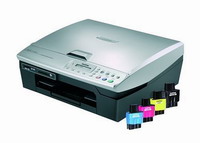Xerox Corp introduces color printers and ink products
New color printers and ink products of Xerox Corp. will cut the price of color copying by two-thirds.

Color printing and copying are increasingly attractive to U.S. and overseas businesses that want an edge in marketing and other presentations. But the high cost of color production has hindered efforts by Xerox to make greater inroads in the market, the Stamford-based office equipment manufacturer said.
"We're making color more accessible, more affordable and easier to use for offices large and small around the world," Jim Rise, vice president and general manager of Xerox's solid ink products business unit, told investors in a webcast Monday.
The company's new printers and updated solid-ink technology will reduce the price of color copying and printing to the cost of black-and-white printing, boosting Xerox's drive for more customers in the highly competitive color market, he said.
"Our feedback from customers and third-party research is that color is too expensive," Rise said before the announcement. "That's the barrier to broad use of color in the office."
The new printers use longer-lasting crayon-like ink sticks that will help reduce the cost of printing, the company said. In development for nearly five years, the new ink sticks are now larger and more dense.
Together with the new machines, the ink will cut the cost of color copying and printing from the 15 cents a page to 5 cents - the price of black-and-white printing.
The new products target businesses with print volume of between 2,000 and 10,000 pages a month - firms such as real estate agencies, marketing companies, design agencies and contractors that use color printing for business proposals, reports, photographs and presentations.
Rise said the two printers will cost $2,499 (1,771 EUR) and $3,999 (2,833 EUR), or about $900 (638 EUR) more than equipment handling the same volume sold by competitors. However, with the lower cost of ink, the higher equipment price will be recovered in five months, Xerox says.
But Tom Codd, director of outbound marketing for Hewlett-Packard Co.'s LaserJet business, predicted the Xerox printers will be more expensive to operate because the crayon-like ink sticks must be melted before each use. Hewlett-Packard doesn't use wax-based ink systems in its printers.
"They're certainly taking a different approach to the printing market," Codd said.
Hewlett-Packard, Ricoh Co., Canon U.S.A. Inc. and Eastman Kodak Co. are competitors of Xerox.
Color products have been a financial boon for Xerox. Revenue from Xerox's color copier and equipment business increased 12 percent in the second quarter, to $1.5 billion (1.06 billion EUR), or about 38 percent of total revenue, up from 34 percent in the same quarter last year.
Xerox has said it expects earnings to grow this year largely due to increased demand for color printing and document services. The company intends to launch twice as many products in 2007 as last year when it introduced 14 products. Many of the new launches are in color products.
Shannon Cross of Cross Research said Xerox has a "huge opportunity to transition to color."
"Growth is obviously in the color," she said.
David R. Spencer, president of SpencerLab Digital Color Laboratory, a Melville, New York-based test laboratory for color digital printing devices, said Xerox could have an edge over competitors because it has control over its ink product, which is proprietary. SpencerLab tested one of Xerox's new machines.
The cost of color printing and copying is so expensive for some companies that the use of color copying machines is often restricted to only a few employees, he said.
"Having a machine that prints color at the same cost as black and white would change that dynamic," Spencer said.
Subscribe to Pravda.Ru Telegram channel, Facebook, RSS!





